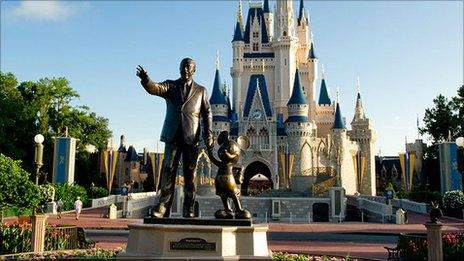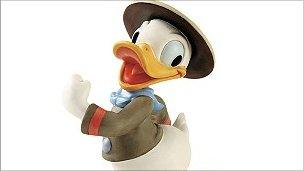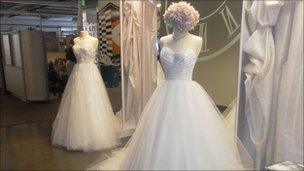'Would Walt have done that?'
- Published

Walt Disney was both a prolific genius and a risk-taker
On a plinth in front of the Magic Castle, a statue of Walt Disney holding Mickey Mouse's hand welcomes visitors to Disney World in Florida.
It was 1955 when Walt Disney opened his first theme park at Disneyland in California, but that was not the only thing he achieved that year.
He also released the animated movie Lady and the Tramp, the live-action movie 20,000 Leagues Under the Sea and he won an Oscar for a documentary series entitled The Vanishing Prairie, about the disappearance of the buffalo herds of North America.
Disney is recognised as a prolific genius, though it is not widely known that he was also a calculated risk-taker.
Dramatic growth
Since Disney's death in 1966, the business segment of the Walt Disney Company, Disney Consumer Products, has followed in his footsteps, taking calculated risks that have helped make one of the world's most successful brands even more successful.
Andy Mooney used to run the show, having joined Disney 11 years ago from the sportswear firm Nike, where he had spent the previous two decades.

At Disney there is no need to invent cool says former executive Andy Mooney
Under Mr Mooney's chairmanship, which ended this summer, Disney Consumer Products' global retail sales almost trebled to some $30bn (£19bn, 22bn euros) in 2010.
Disney's corporate strategy has been to re-release Walt's ideas and concepts at opportune moments, but with what it describes as "21st Century relevance".
Imagine an army of Santa's helpers manning the consumer products arm's five divisions - Disney Toys, Disney Fashion and Home, Disney Food, Health and Beauty and Disney Stationery - and it becomes clear how the strategy has been carefully honed to deliver impressive corporate results.
"Disney-branded merchandise have grown at a compounded rate of 12% per annum over the last 10 years," according to a company press release.
Expansive vision
Having left the company, Mr Mooney recalls how he learnt a lot from Walt Disney's way of thinking throughout his time there.
"When you think about the guy's vision, and the expansiveness of his vision," he says, "no marketing textbook would ever have said that you can do all these things under the one brand simultaneously.
"But he had a quality level and a perspective on life that enabled him to do it."
Mr Mooney insists Disney "should be experimenting with new things, as long as the taste level and the quality level remain high and comparable with the values of the brand".
But the biggest lesson he has learnt has been to think twice before messing with the stuff that has always been an integral part of the brand, namely the Disney story behind it.
"I didn't bring him with me, but I hooked up with a guy that I worked with at Nike," Mr Mooney recalls, "and he and I mistakenly tried to invent 'cool' when we got here."
They soon realised that that was a waste of time and effort.
"When we both stumbled into the archives together, we just sat there and went 'Wow - cool is sitting right here. We don't have to invent it, we just have to expose it.'"
Lifestyle choice
One way to do that has been to allow Minnie Mouse run riot in the Forever 21 chain of stores with her own collection, complete with signature mouse ears, darling bows and polka dots.
But the "cool" stuff is not limited to Disney characters such as Minnie, or indeed Mickey Mouse or Donald Duck.
So for those who really want to assimilate, there is a Disney Princess wedding dress collection, inspired by the style and personality of the characters from Walt's films.

Branching out into wedding dresses has proven a profitable move
Robert Oberschelp, director of Disney Collections, knew the dresses would sell, given that some 40,000 couples have used Disney's Fairy Tale Weddings & Honeymoons during the past two decades.
After the wedding, there might be time to go shopping for Disney's very own "upscale newborn, infant and toddler collection", inspired by Disney artist Mary Blair's original artwork and launched jointly with department store chain Nordstrom.
And perhaps to furnish the new family home with a reproduction of an original Airline Chair from 1934, which Walt had selected for the animator's offices when he built the Disney animation studio in Burbank, California.
The chair has also been reproduced by the Disney Collections, and it is sold alongside home cinema furniture inspired by the film Fantasia, released in 1940, in which Walt was the first person to introduce the very first version of surround sound.
New talent
Beyond the home, the Disney company has taken to the streets, inviting graffiti artists to interpret Disney's most treasured asset, Mickey Mouse.
"That's not something that most people would see Disney doing," says Pamela Lifford, who works for Disney's Global Fashion and Home division.
"But what you know is, these guys are highly creative and you would be surprised that most of them know a lot about our history and heritage and creativity."
Ms Lifford is convinced Walt would have loved it.
"He'd be be pleased to have left such a wealth of content that could be leveraged decade after decade and be an inspiration for all things new," she smiles.
"And he'd be pleased that what he stood for and the strong foundation that he laid could continue to attract new thinking and new talent, but with a high sense of respect and commitment to protecting the history of Disney."
- Published7 October 2011
- Published21 September 2011
- Published9 August 2011